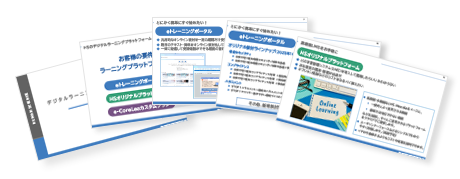2020.11.02
e-Learning in Corporate Training Basics ④ (Failed e-Learning)
E-learning has already been adopted by many companies.
However, the evaluation of e-learning that I hear from corporate educators and participants tends to be harsh. Of course, there are companies that utilize it well, and it is also important to understand that there cannot be content that satisfies all participants.
One answer to how to succeed is that the learners themselves feel the need for that education and want to learn. Those providing the education must consider ways to engage interest, or else they must implement strategies to reinforce memory and encourage action, otherwise the learning time that has been carefully allocated will become wasted time.
To draw out the motivation of participants and provide the keys to successful e-learning, we will introduce examples of e-learning failures. These are not issues limited to specific companies or organizations.

This e-learning will fail!
Based on my experience observing the e-learning content and implementation status of many clients due to my work, I will introduce three failure cases. Each of these is a common type of failure.
*Please note that some parts have been intentionally modified to avoid identifying specific clients.
Case Study of Company A: Well-crafted teaching materials by engineers!
Accurate information and information optimized for e-learning are different.
In this case, the writing was done by someone who was familiar with the content of the teaching materials and was also providing instruction, but in order to reach a larger audience, the amount of information in the materials was enormous. Due to the inclusion of various annotations and many in-depth points, even when looking at just one slide, it was overloaded with information, making it difficult to grasp the key points. Additionally, as a result, the time required for each course exceeded one hour, making it not something that could be learned casually. Furthermore, due to the high level of specialization and complexity of the content, we found ourselves in a situation where even updating the content was difficult without confirming with the author.
Case Study of Company B: If everyone crosses at a red light, there's nothing to fear
I have repeatedly mentioned in past blogs that a "learning culture" is important, but there are cases where a "non-learning culture" has taken root.
In this case, the participants prioritized their work, and furthermore, since studying during work hours is not permitted by local law, they found themselves in a situation of "I have to finish this quickly, no matter what." Specifically, they would skip through slides by repeatedly clicking the "Next" button or share answers for the tests among themselves.
The cause lies not with the individuals but with the surrounding organizational culture, yet the proposed measures included setting the "Next" button to be unclickable immediately and implementing randomized questions. If operations are tightened under these conditions, the image of e-learning will worsen, and both content understanding and learning effectiveness will not improve. A vicious cycle could occur, leading to a situation where "rules are made stricter," which could "invite backlash"... creating a spiral that is hard to escape.
Case Study of Company C: The Act of Creating as the Purpose
When belonging to an organization, following decisions and orders from superiors tends to become the top priority. While this is certainly important, it can lead to forgetting the need to review plans and the original objectives.
In this case, adhering to the schedule and the secured budget took precedence, and the original goals such as "sales representatives understanding the differences between products A, B, and C and being able to propose the appropriate products to customers" were neglected. Additionally, implementation purposes and goals (business impact) such as "increasing the success rate of negotiations by X%" and "increasing sales profit by X%" were not set.
By proceeding with production as is, who, when, and where the learning materials are for were not sufficiently considered, and the reason why the materials are necessary was not shared with stakeholders. Despite the emergence of technical and quality issues during development, as well as the timing for reconsidering deadlines, only superficial improvements were made, and no fundamental review of the plan was conducted. As mentioned earlier, these goals were not properly communicated to the learners, leading to confusion among participants and insufficient results.
Summary
Company A has issues with content creators, Company B has issues with the learning environment, and Company C has issues with objectives and goals. The degree and scope may vary, but it can be said that this is a situation that occurs in many companies that have implemented e-learning.Even if the quality of the content is good, it will not lead to success. It can be said that the awareness and recognition of the creators, as well as the design that takes into account the environment in which the learners are placed, and the creation of that environment are also important.
After reading the three examples above, some of you may have been able to imagine how success was achieved. However, the success of e-learning varies due to slight differences (such as existing organizational culture, environment, and individual attributes), so there is no absolute solution.

Author:
Keigo Tachino
Education Solutions Department Consulting Unit
・Experience as a training instructor, web designer, etc.
・Engaged in instructional design, e-learning development, etc.
・Learning Designer (eLC certified)
・ATD International Professional Member
Contact Information:
Phone Number: 03-5321-3111
hsweb_inquiry@science.co.jp
Case Studies of Companies that Have Implemented Our Services e-Learning Services
Case Study Collection
From support for the introduction of e-learning to the production of teaching materials, Human Science offers a variety of services related to e-learning.
In this case study collection, you can view the implementation examples of five companies that have used our services. Please take this opportunity to download it.

[Introducing Companies]
- Fuji Xerox Service Creative Co., Ltd.
- NIPPON DENSETSU KOGYO CO.,LTD. Dear
- Sanken Electric Co., Ltd.
- The Open University of Japan
- Okinawa Institute of Science & Technology Graduate University Dear
5 case studies of companies












